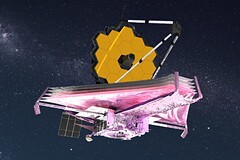Washington. January 8th. INTERFAX - Experts have completed the deployment of components of the world's largest and most powerful James Webb Space Telescope (JWTS) worth $ 10 billion to study the processes of evolution of the Universe, follows from the broadcast, which is conducted by NASA.
"We confirm the full deployment of the James Webb Space Telescope Space Observatory," NASA said.
According to NASA, the last step before bringing the observatory into working condition - the deployment of the main mirror, was completed at 10:28 am US East Coast time (18:28 GMT). Subsequently, within a few hours, the specialists carried out the fastening of four clips installed on the side mirror panel to ensure reliable fixation of the mirrors before their calibration.
The telescope was launched on December 25 at 15:20 Moscow time from the launch complex at the Kourou cosmodrome in French Guiana using an Ariane 5 heavy launch vehicle.
Bringing the telescope components into working condition lasted a little more than two weeks. During this time, solar panels, communication antennas, a heat shield and auxiliary mirrors were deployed.
The James Webb Station, developed by NASA in collaboration with the European Space Agency (ESA) and the Canadian Space Agency (CSA), is an orbital infrared observatory that will replace the Hubble Space Telescope launched in 1990. Compared to it, the JWTS will be 100 times more powerful thanks to the latest photosensitivity technologies used. Among the main tasks of the James Webb telescope is to detect the light of the first stars and galaxies that formed after the Big Bang.
He will study the early universe - the composition of the first stars and the evolution of galaxies. According to scientists, the universe is approximately 13.8 billion years old. The telescope will be able to record the radiation of objects that formed about 100-250 million years after the Big Bang. In addition, the telescope's tasks include the study of planetary systems and the search for signs of life on exoplanets.
The new 6.2-ton space observatory has a composite (of 18 hexagonal segments) mirror 6.5 meters in diameter with a collecting surface area of 25 square meters, which will make it possible to view the most distant objects of the Universe. For comparison, Hubble has a mirror measuring 2.4 meters with a collecting surface of 4.5 square meters.
The James Webb telescope is equipped with a huge five-layer thermal screen, the size of which is comparable to a tennis court. The screen is designed to protect the observatory from sunlight in order to maintain the temperature of the mirror and instruments below minus 220 degrees to ensure working conditions in the infrared radiation range.
It is planned that 29 days after the launch, the space telescope will have to go to the so-called L2 Lagrange point, at a distance of about 1.5 million km from Earth, from where it will begin to fully perform its tasks in mid-2022.

